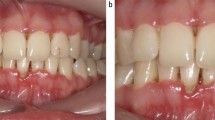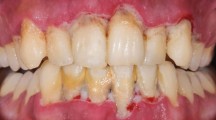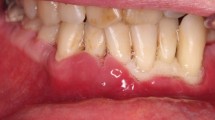Key Points
-
Ligneous periodontitis is a newly described and a rarely seen entity that is caused by plasminogen deficiency and resultant fibrin deposition. Dental practitioners should be aware of this systemic disease.
-
Patients with destructive membranous lesions of the periodontal tissues should always be systematically evaluated and should be thoroughly examined for possible involvement of the skin and other mucosal surfaces.
-
A gingival biopsy will bring early diagnosis before the teeth were lost.
Abstract
Destructive membranous periodontal disease is a rare, destructive and poorly defined entity, which is the part of a systemic disease due to plasminogen deficiency and fibrin deposition. The disease is characterised by gingival enlargement and periodontal tissue destruction that leads to rapid tooth loss despite treatment attempts. Biopsy is essential to rule out other periodontal disease in the differential diagnosis.
Similar content being viewed by others
Case Report
A 32-year-old Turkish woman was referred to our clinic for extraction of mobile teeth. Intra-oral examination revealed painless, massive, fragile, nodular, gingival enlargements on both the maxilla and the mandible. The lesions consisted of white-yellow membranes that almost completely covered the teeth and bled easily on manipulation. Most of the teeth were missing. Radiographic examination revealed severe bone-loss at the jawbones. Several treatment efforts for oral lesions in different clinics such as subgingival curettage, gingivectomy, clorhexidine rinsing and antibiotics were unsuccessful in the past.
See Figure 1
The patient's medical history revealed nodules, vaginal discharge, menstrual disorder and chronic conjunctivitis with acute attacks at least twice yearly. Haematological assessment revealed no abnormalities. Biochemical tests including serum proteins, liver function tests, azotemia and glycaemia were within normal limits. Kidney function tests were normal and hormonal values were also within normal limits. There was no history of prolonged use of medication. A gingival biopsy was performed before the treatment planning. The histopathologic examination confirmed the diagnosis as ligneous periodontitis. After this diagnosis, the patient consulted the ophthalmology clinic and ligneous conjunctivitis was also detected. Since none of the patient's remaining teeth had periodontal support, all of them were extracted in stepwise fashion. Four weeks after the last extraction, there was noticeable regression of mandibular lesions, but the lesions on the anterior maxilla remained unchanged for 12 weeks. At this stage, the lesions were excised and skin graft vestibuloplasty was performed because of the insufficient vestibular sulcus depth on the anterior maxilla. Seven days after this operation, some of the skin graft was rejected because of necrosis. The necrotic part of the graft was removed and rinsed with betadine (7.5%) postoperatively since secondary epithelialization was occurring at the rejected area. After the healing process was finished, a set of complete dentures was prepared. At the time of writing, the patient had worn the dentures for around 3 years with no complaints.
See Figure 2, Figure 3 and Figure 4
Discussion
Gingival hyperplasia may be genetic in origin or may occur as a result of a reaction to dental plaque or as a result of exposure to a number of agents, particularly drugs such as phenytoin, cyclosporine or the calcium channel blockers.1,2 However, a few new cases of gingival hyperplasia have been identified as part of a systemic syndrome.2 Destructive membranous periodontal disease (ligneous periodontitis) is a rare, poorly defined entity characterised by gingival enlargement and periodontal tissue destruction.3 The cause of this condition is due to plasminogen deficiency and resultant fibrin deposition.2,4 The periodontal lesions are produced by the same process that causes ligneous conjunctivitis. In most instances, ligneous conjunctivitis might represent an autosomal recessive disorder.4 Since 1997, Schuster et al. demonstrated distinct homozygous and compound-heterozygous mutations in the plasminogen gene to be common in patients with ligneous conjunctivitis and clearly confirmed autosomal-recessive inheritance of this disorder.5 Most of the reported oral lesions were seen together with ligneous eyelid lesions. However, only a few of the reported cases of ligneous conjunctivitis have coexisted with oral and dermatological lesions.3,4,6 Therefore, patients with destructive membranous lesions of the periodontal tissues should always be systemically evaluated and should be thoroughly examined for possible involvement of the skin and other mucosal surfaces. In the reported case, oral and eyelid lesions were seen together but there were not any dermatological lesions related with the disease. The differential diagnosis includes other progressive periodontal diseases and gingival hyperplasias. Localised gingival amyloidosis and ligneous periodontitis show some similarities but differential diagnosis can be made by histopathologic examination as reported gingival lesions were stained for fibrin but negatively for amyloid.
Extensive membranous, nodular gingival enlargements in both mandible and maxilla leading to rapid tooth loss despite treatment attempts are the most characteristic features of this rare destructive periodontal disease.3 Scully et al. stated that the reported cases might fall within a spectrum of disorders related to plasminogen deficiency and very closely related with ligneous conjunctivitis, but distinct from it, because few patients had lesions of other mucosae and the gingival deposits had different staining characteristics.4 The gingival lesions reported in association with this entity reveal that they were progressive and usually end with loss of teeth.2,3,4,6 Several surgical and periodontal treatment efforts were unsuccessful in all the reported oral lesions.2,3,4,6 In some cases, gingival lesions show regression or disappear following tooth loss,3 but there is not any reported period for the regression of the lesions in the literature. In the present case, 4 weeks after the last extraction, mandibular lesions regressed slowly and disappeared but maxillary lesions remained unchanged for 12 weeks.
Ligneous lesions tend to involve several mucosal areas; systemic fibrinolytic and antithrombotic agents may be more beneficial than local treatments.3 Scully et al. reported that therapy with topical heparin or intravenous purified plasminogen concentrate will effectively control the gingival lesions. This remains to be established, as plasminogen concentrate is not yet widely available.4 Although systemic therapy is suggested for this disease, loss of the teeth and necessity of vestibuloplasty for this patient led us to a surgical treatment modality.
Conclusion
Extensive membranous, nodular gingival enlargements that do not respond to surgical and periodontal treatment modalities may be a part of a systemic syndrome due to plasminogen deficiency. In such mucosal disorders, gingival biopsy is essential for early diagnosis before the teeth are lost.
References
Porter SR, Scully C . Periodontal aspects of systemic disease. In: Lang N P, Karring T (eds). Proceedings of the 1st European Workshop on Periodontology. London: Quintessence, 1994, p.375–414.
Gökbuget YA, Mutlu S, Efeoglu A, Porter SR, Erseven G, Karacorlu M . Amyloidaceous ulcerated gingival hyperplasia: A newly described entity related to ligneous conjuctivitis. J Oral Pathol Med 1997; 26: 100–104.
Günhan Ö, Günhan M, Berker E, Gürgan CA, Yildirim H . Destructive membranous periodontal disease (ligneous periodontitis). J Periodontol 1999; 70: 919–925.
Scully C, Gökbuget YA, Allen C et al. Oral lesions indicative of plasminogen deficiency (hypo-plasminogenemia). Oral Surg Oral Med Oral Pathol Oral Radiol Oral Endod 2001; 91: 334–337.
Schuster V, Zeitler P, Seregard S et al. Homozygous and compound-heterozygous type I plasminogen deficiency is a common cause of ligneous conjunctivitis. Thromb Haemost 2001; 85: 1004–1010.
Günhan Ö, Celasun B, Perrini B, Özdemir A, Bostanci H, Finci R . Generalised gingival enlargement due to accumulation of amyloid like material. J Oral Pathol Med 1994; 23: 423–428.
Author information
Authors and Affiliations
Corresponding author
Additional information
Refereed Paper
Rights and permissions
About this article
Cite this article
Baykul, T., Bozkurt, Y. Destructive membranous periodontal disease (ligneous periodontitis): a case report and 3 years follow-up. Br Dent J 197, 467–468 (2004). https://doi.org/10.1038/sj.bdj.4811739
Received:
Accepted:
Published:
Issue Date:
DOI: https://doi.org/10.1038/sj.bdj.4811739
This article is cited by
-
Plasminogen deficiency
Journal of Thrombosis and Thrombolysis (2017)
-
Periodontitis associated with plasminogen deficiency: a case report
BMC Oral Health (2015)







